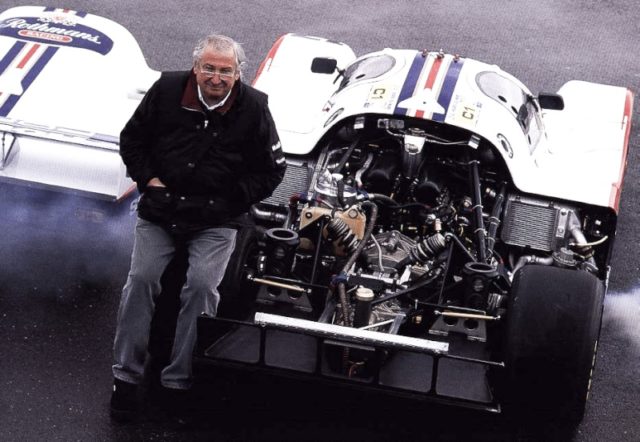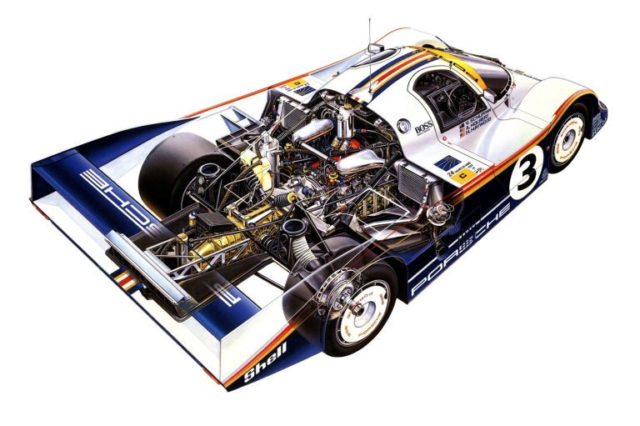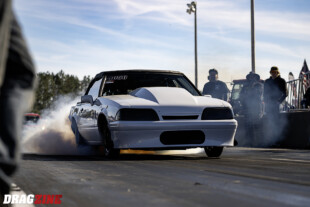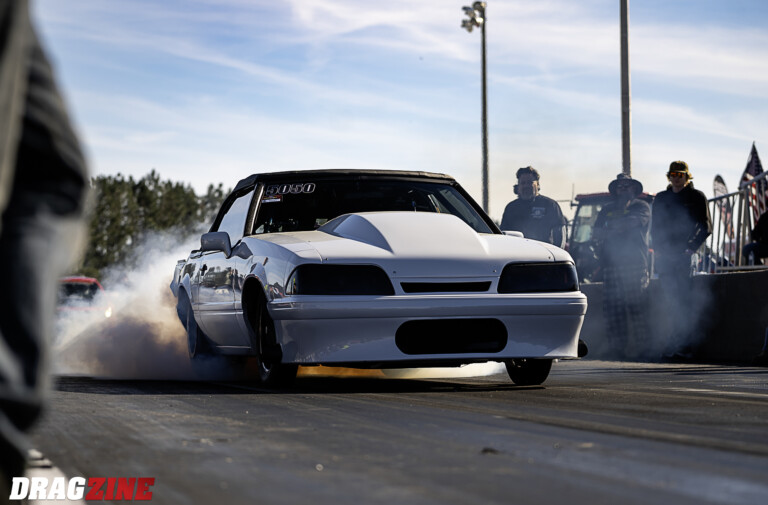It can be said with some confidence that nothing quite defined sports car racing in the eighties as well as the Porsche 956/962. Its sleek looks made it noticeable, but so did the consistent finishes. As sports car racing was—and still is—known for incredible, near-F1 performances, the remarkable build quality is often looked over. However, any self-respecting racing nerd will appreciate the engineering expertise that’s required to make an 800-horsepower thoroughbred last 24 hours, dominate sprint racing, and become one of the most sought out turnkey racers by works teams and privateers alike. In short, the Porsche 956/962 is the daddy–and with stars in his eyes, Chris Harris had the chance to sample a longtail 962 with the iconic Rothman’s livery.
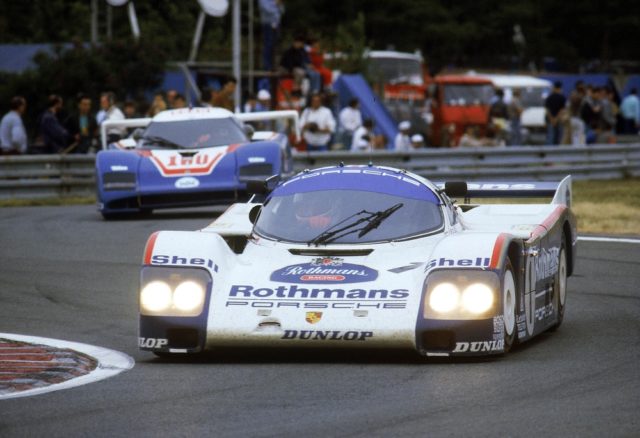
Aside from the Marlboro McLarens, there are no liveried racing cars more iconic than the Rothmans 956/962s. Photo credit: 95 Customs
The Porsche 956 made its debut in the early 1980s when ground effect was en vogue. This approach to generating downforce began with the skirted Lotus F1 cars of the late seventies, and was introduced to the world of sports cars with the Lola T600 and BMW M1/C. However, sliding skirt design would not work on a wider sports car, and so Porsche worked feverishly to find an alternative means of suction. With lots of trial and error, they eventually figured to funnel air from the sides of the car through the venturi tunnels. This gave the engineers an estimated three times the downforce generated by the 956’s spiritual predecessor, the 917.
Porsche designed the 956 in response to the rules of the brand new Group C category. It used an aluminum monocoque to keep weight down to the class minimum of 1,764 pounds. With anywhere from 620 to 750 horsepower on tap and long gearing, the 956 was happy to hit 235 miles an hour down the Mulsanne Straight in the days before the dreadful chicanes.
https://
However, the gearboxes weren’t as enthusiastic about the challenge. With that much power fed through the gearbox and the time spent at maximum revs, fifth gear took a beating was was prone to fail. That might’ve been its Achilles’ heel, since the car became renowned for its remarkable durability—one reason why it became so popular with well-heeled amateurs and smaller teams.
Another reason for its widespread popularity was its soft edges; the chassis was an absolute peach. “It was a fabulous car, but considering how thorough Singer and the team were, it was really quite easy to drive,” according to Derek Bell. To complement that praise, Dominic Dobson, who spent many years racing these beasts, notes “it rode like a road car!” Perhaps that’s why the 956 managed a 6:11 lap around the bumpy Norschleife in the hands of the talented Stefan Bellof.
Soft-edged, reliable, and aided by a herculean powerplant, the demand for the 956 grew, and eventually, it populated fields the world across. Al Holbert helped bring the 956 to the United States, though with a slew of modifications to keep the car current, it would be known as the 962 from 1986 onwards. The American IMSA GTP series was primarily raced at street circuits, and with plenty of slow, tight corners to contend with, Holbert optimized the intercooling system by relocating the units to the roof to reduce pipe length and improve turbo response. Perhaps the most distinctive change to the car was the relocation of the driver’s feet behind the front axle line to reduce the likelihood of shattered legs in a frontal collision. His efforts led to the 962 winning the 12 Hours of Sebring four times in the mid-eighties, and claim the IMSA Camel GT title several times during that period. Not bad for a turnkey racing car—and it actually started on a key that resembled those that started Porsche roadcars of the era!
The 956 won its first race at Le Mans (1982) as well as its last (1985), and the 962 went on to win the following two years. However, towards the end of the decade, turbocharged racing cars were becoming too expensive and, in theory, too dangerous to race. In 1991, the ACO—organizers of the 24 Hours of Le Mans—enacted a 1,500-pound minimum for normally aspirated cars, whereas the turbocharged entrants had to be 1,830 pounds at their sveltest. Hardly fair, but even then the organizers tacked on another 220-pound handicap to the force-fed contenders, which would be prevented from qualifying in the top ten at Le Mans regardless of their lap times. These rules effectively killed the Group C category, though some would say a very expensive engine formula introduced then is what fell the final blow. At that point, the 962 and the other turbocharged entrants should’ve been completely eradicated from competition.
However, the 962 still managed to take third at the ’91 12 Hours of Sebring and win Le Mans ’94, despite running with much quicker, newer machinery. Even though the 962 was getting a little long in the tooth, it still dotted rosters and finished towards the sharper end of the pack on both sides of the Atlantic. Nevertheless, for a car that competed so well across a decade of change filled with pricey, technological innovation and the nasty influence of big manufacturers, it’s a car worth tipping your hat to.
The combination of a wildly-powerful turbo motor that gained serious grunt every year, an advanced underbody that provided incredible cornering speeds, and a level of resilience that kept it relevant were what made it so dominant. However, it was more than just a strong competitor. What these elements represented was a bygone time when engineers could still make massive steps forward in development; so much was not fully understood then. Nowadays, teams struggle to find tenths of a second by refining winglets and canards, but thirty years ago, a car could remain competitive over a lengthy career with clever engineering and innovation, which this Porsche came to be associated with.



